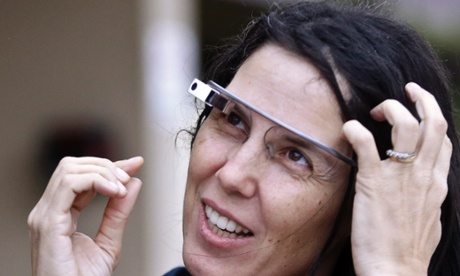Tech
Google Glass driving charge: owner pleads not guilty to using device

First case could be test of rule against using distracting technologies while driving, as Cecilia Abadie fights ticket in California court

Cecilia Abadie wears her Google Glass as she talks with her attorney outside of traffic court Tuesday, Dec. 3, 2013, in San Diego. When Abadie was pulled over on suspicion of speeding in October, the officer saw she was wearing Google Glass and tacked on a citation usually given to drivers who may be distracted by a video or TV screen. She pleaded not guilty to both charges on Tuesday. (AP Photo/Lenny Ignelzi) Photograph: Lenny Ignelzi/AP
A California woman pleaded not guilty on Tuesday to what is believed to be the first traffic citation over a motorist allegedly using Google’s Glass device while driving.
Google Glass features a thumbnail-size transparent display above the wearer’s right eye – which could be interpreted as equivalent to a TV under the law.
The technology will not be made widely available to the public until 2014, but defendant Cecilia Abadie is one of about 10,000 “explorers” who received the glasses earlier this year as part of a tryout.
Her case touches several hot-button issues, including distracted driving, wearable technology that will one day become mainstream, and how laws often lag technological developments. Similar rules banning the use of TVs in cars by drivers apply in the UK.
Abadie, a founder and developer at 33 Labs who says she was one of the first 200 people to try Google Glass, was pulled over in October on suspicion of going 80 mph (129 kph) in a 65 mph (105 kph) zone on a San Diego freeway. The California Highway Patrol (CHP) officer saw she was wearing Google Glass and tacked on a citation usually given to people driving while a video or TV screen is on in the front of their vehicle.
Abadie pleaded not guilty to both charges in San Diego traffic court.
The outcome of the case could have important ramifications for the use of Glass by groups such as delivery drivers, who might want to use Glass to get driving directions while on the way to locations.
Abadie’s attorney William Concidine told The Associated Press that she will testify at a trial scheduled for January that the glasses were not on when she was driving, and activated when she looked up at the officer as he stood by her window.
The device is designed to respond to a head tilt by waking itself up.
Concidine also said the vehicle code listed in the citation applies to video screens in vehicles and is not relevant to mobile technology such as Google Glass.
The CHP declined comment on Concidine’s assertions.
At the time of Abadie’s citation, the agency said anything which takes a driver’s attention from the road is dangerous and should be discouraged.
The lightweight frames are equipped with a hidden camera and tiny display that responds to voice commands. The technology can be used to do things such as check email, learn background about something the wearer is looking at, or to get driving directions.
Legislators in at least three states Delaware, New Jersey and West Virginia have introduced bills that would specifically ban driving with Google Glass.
Chris Dale, a spokesman for Google, said he was not aware of any other tickets issued for driving with Google Glass.
Google’s website contains an advisory about using the headgear while driving: “Read up and follow the law. Above all, even when you’re following the law, don’t hurt yourself or others by failing to pay attention to the road.”
Article read in the theguardian






